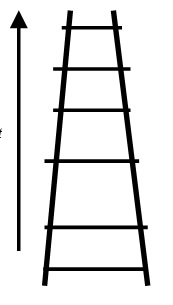Change Implementation Techniques for Laying a Foundation for New Ways
Technique 1.29 Climbing out of the Muck
(how self‐reflection and inquiry can help to break free of the recurring impasses)
Introduction
. We have automatic, unconscious processes that occur in our thoughts as we reach conclusions about our experiences. Often we reach knee‐jerk conclusions with no intermediate thought processes, as if rapidly climbing up a ladder in our minds, as follows:
. Observable data and experiences leads us to select data according to our perception of reality; this leads to adding meaning, according to our own perspective; then to make assumptions, draw conclusions and adopt beliefs
. Introducing the ladder of inference into a conversation acts as a kind of circuit breaker: it allows questions to be asked, such as "what meaning do you ascribe to those facts?" Or "what assumptions do you make that enable you to come to conclusions?"
. The ladder of inference is a conceptual device showing how different people may interpret the same situation very differently, and never know (unless they talk openly about it). The lowest rung, at the bottom, contains readily observable data, such as a sentence uttered, that could be checked. People tend to mentally rise to more abstract, unverifiable levels ‐ which might include the cultural meaning (as understood by anyone in the community), to conclusions and beliefs that move further away from the original "reality" of the conversation. The muck is thickest at the top of the ladder.
Ladder of inference
| I take action based on my beliefs |
| I adopt beliefs about the world*i |
| I draw conclusions |
| I make assumptions based on meanings added |
| I got meanings (cultural and personal) |
| I select data from what I observe*i |
| Observable data and experiences |
(source: Rick Ross, 1994)
Notes
i) The reflective loop (our beliefs impact what data we select)
For example
Remember the dialogue starts at the bottom of the ladder!!!!!!
|
i) She then says "Bob, it's plain as day. You think everything's my fault, and you're motivated to get me." |
|
|
ii) Diana thinks: Obviously Bob always disapproves of the way I do things |
|
|
iii) Bob thinks: I don't know how to handle this type of situation, but I don't want to say so |
|
|
iv) She thinks: Bob is expressing criticism of me |
|
|
v) Bob says, "Diana, you were advocating and not inquiring just now." |
NB Dialogue starts here
This process involves
Collecting data on things you say and do
Accounting for evaluating what happened:
‐ what results did I get, ie how do people react to my actions?
‐ what did I like about the results I got? What don't I like? What did they do next?
‐ what did I say or do to help create these results?
‐ how do I see the situation, myself, and how did others in the room?
‐ how does this inform me of my actions? How might my actions have made sense, given the way I view the situation?
‐ what aspects of this particular situation did I find challenging?
Reflecting with others by:
‐ explicitly describing the data you have selected
‐ explicitly describing how you interpret that data
‐ asking others for their comments and interpretations
When we interact with others, our senses are exposed to a massive flood of perceptual and sensory data. Your brains selectively choose which data to take notice of, ie interpret.
Usually, the brain selects the data that supports your assumptions, beliefs, values, etc and rejects the data that challenges or threatens your assumptions, etc; this often happens without conscious effort. This can lead to misinterpretation and unsuitable action can result. This can be misunderstood by others who have their own selective filters evaluating words, actions, etc. Thus there is a disconnect between how we think and act with your 'espoused theory', ie
"...- maximise valid information
- maximise free and informed choice
- maximise internal commitment to decisions made
Instead, we act out our 'theory of action' (the theory others would assume our actions reveal)
- define goals and unilaterally try to achieve them
- maximise winning, minimise losing
- minimising generating or expressing negative feelings..."
Bob Dick, 2022
Setting conflict to work, ie the fact we pose difficulties for one another becomes an asset, not a liability, by seeing one another's downside as an opportunity to expand abilities to help a much wider range of people in a wider variety of circumstances
Acknowledging inconsistency; ie there is a gap between the behaviour you espouse and your actions in real‐life
Being humble in your efforts and compassionate towards imperfections, including your own
Investing in outside help
(sources: Peter Senge et al, 1999; Bob Dick et al, 1997; Mike Hanley, 2005)

